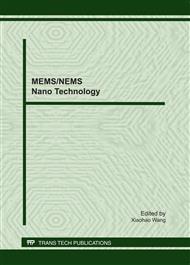[1]
Y. Cui, C.M. Lieber: Functional nanoscale electronic devices assembled using silicon nanowire building blocks. Science. Vol. 291( 2001), pp.851-853.
DOI: 10.1126/science.291.5505.851
Google Scholar
[2]
Y. Cui, Q.Q. Wei and H.K. Park: Nanowire nanosensors for highly sensitive and selective detection of biological and chemical species. Science. Vol. 293(2001), pp.1289-1292.
DOI: 10.1126/science.1062711
Google Scholar
[3]
Y. Cui, Z.H. Zhong and D.L. Wang: High performance silicon nanowire field effect transistors. Nano Lett. Vol. 3(2003), pp.149-152.
DOI: 10.1021/nl025875l
Google Scholar
[4]
J. Goldberger, A.I. Hochbaum and R. Fan: Silicon vertically integrated nanowire field effect transistors. Nano Lett. Vol. 6(2006), pp.973-977.
DOI: 10.1021/nl060166j
Google Scholar
[5]
A.M. Morales, C.M. Lieber: A laser ablation method for the synthesis of crystalline semiconductor nanowires. Science. Vol. 279(1998), p.208.
DOI: 10.1126/science.279.5348.208
Google Scholar
[6]
N. Wang, Y.F. Zhang, Y.H. Tang, C.S. Lee and S.T. Lee: Silicon nanowires prepared by laser ablation at high temperature. Appl. Phys. Lett. Vol. 73(1998), p.3902.
Google Scholar
[7]
D.P. Yu, Z.G. Bai and Y. Ding: Nanoscale silicon wires synthesized using simple physical evaporation. Appl. Phys. Lett. Vol. 72(1998), p.3458.
DOI: 10.1063/1.121665
Google Scholar
[8]
H.F. Yan, Y.J. Xing and Q.L. Hang: Growth of amorphous silicon nanowires via a solid-liquid-solid mechanism. Chem. Phys. Lett. Vol. 323(2000), pp.224-228.
DOI: 10.1016/s0009-2614(00)00519-4
Google Scholar
[9]
J.D. Holmes, K.P. Johnston, R.C. Doty and B.A. Korgel: Control of thickness and orientation of solution-grown silicon nanowires. Science. Vol. 287(2000), p.1471.
DOI: 10.1126/science.287.5457.1471
Google Scholar
[10]
N.L. Wang, Y.J. Zhang and J. Zhu: Growth of silicon nanowires via nickel/SiCl4 vapor-liquid-solid reaction. J. Mater. Sci. Lett. Vol. 20(2001), pp.89-91.
Google Scholar
[11]
K.K. Lew, C. Reuther and A.H. Carim: Template-directed vapor-liquid-solid growth of silicon nanowires. J. Vac. Sci. Technol., B. Vol. 20(2002), pp.389-392.
DOI: 10.1116/1.1430240
Google Scholar


